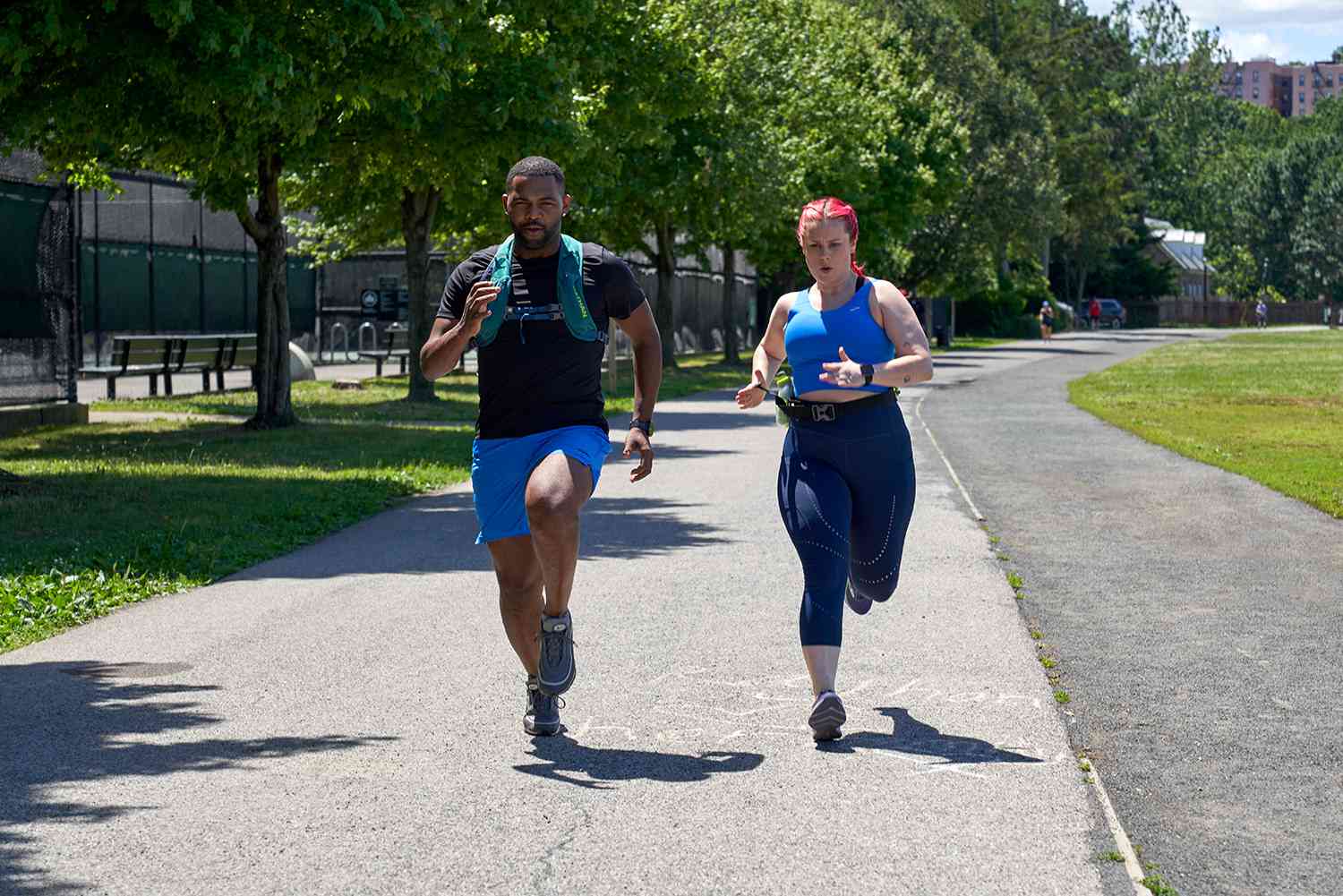Home>Misc>Featured>What Should Your BPM Be For Distance Running


Featured
What Should Your BPM Be For Distance Running
Modified: January 2, 2024
Discover the optimal BPM for distance running with our featured guide. Improve your endurance, speed, and performance with the right BPM.
Introduction
When it comes to distance running, finding the right balance is key. One important factor that can significantly impact your performance is your BPM, or beats per minute. This metric refers to the number of times your heart beats in one minute and is closely associated with your running pace and overall endurance.
Understanding your optimal BPM for distance running is essential for improving your training and achieving your goals. By finding the perfect BPM range, you can maximize your efficiency, prevent injuries, and push yourself further than ever before.
In this article, we will delve into the various aspects of determining your optimal BPM for distance running. We will explore the factors that affect your BPM, discuss the role of heart rate monitors in monitoring BPM, and provide training strategies to improve BPM efficiency. By dispelling common misconceptions, we aim to equip you with the knowledge to enhance your performance and enjoyment of distance running.
So, let’s lace up our shoes, take a deep breath, and explore the fascinating world of BPM and distance running.
Determining Your Optimal BPM for Distance Running
There is no one-size-fits-all answer to what your optimal BPM should be for distance running. It varies from individual to individual and depends on several factors, including your age, fitness level, and running experience. However, there are some general guidelines that can help you determine your optimal BPM range.
One method commonly used is known as the Maximum Heart Rate (MHR) method. It involves subtracting your age from 220 to calculate your maximum heart rate. For example, if you are 30 years old, your maximum heart rate would be 190 beats per minute.
Next, you can determine your target BPM range based on your fitness goals. If you are looking to improve your cardiovascular endurance, a target range of 60-70% of your maximum heart rate is often recommended. For example, if your maximum heart rate is 190, your target BPM range would be 114-133.
On the other hand, if you are aiming to increase speed and push your limits, a target range of 80-90% of your maximum heart rate may be more suitable. In the same example, this would correspond to a BPM range of 152-171.
It’s important to note that these are just general guidelines, and individual variances can exist. Factors such as genetics, fitness level, and overall health can affect your optimal BPM range. Consulting with a healthcare professional or a certified running coach can provide personalized guidance based on your individual needs and goals.
Additionally, it’s essential to listen to your body. If you feel excessively fatigued or experience any unusual symptoms during your runs, it may be a sign that your BPM is too high. On the other hand, if you feel like you’re not challenging yourself enough, it may be an indication that your BPM is too low.
Experimenting with different BPM ranges during your training runs can help you find the sweet spot where you feel comfortable and able to sustain your desired pace for longer distances.
Remember, determining your optimal BPM range is an ongoing process. As you progress in your training and become more attuned to your body’s signals, you may find that your optimal BPM range adjusts accordingly. Continuously monitoring and reassessing your BPM can lead to improved performance and a more fulfilling distance running experience.
Factors Affecting Your BPM
Several factors can influence your BPM during distance running. Understanding these factors can help you better optimize your training and performance. Let’s explore some of the key factors that affect your BPM:
- Fitness Level: Your fitness level plays a significant role in determining your BPM. Generally, those with a higher level of fitness tend to have a lower resting heart rate and can maintain a lower BPM during running. Regular cardiovascular exercise and endurance training can improve your fitness level and positively impact your BPM.
- Pace: The pace at which you run directly affects your BPM. As you increase your running speed, your BPM will also rise. Running at a faster pace requires your heart to work harder to meet the increased demand for oxygen and fuel. Therefore, it is essential to find a pace that is challenging yet sustainable for your fitness level.
- Environmental Conditions: Environmental factors, such as heat, humidity, and altitude, can affect your BPM. Higher temperatures and humidity levels can increase your heart rate as your body works harder to regulate its core temperature. Similarly, running at high altitudes where the air is thinner can also impact your BPM due to reduced oxygen availability.
- Stress and Emotions: Stress and emotions can have a direct impact on your BPM. When you are stressed or experiencing intense emotions like anxiety or excitement, your body releases stress hormones, which can increase your heart rate. Managing stress through techniques like deep breathing and mindfulness can help keep your BPM stable during running.
- Terrain: The terrain you run on can also affect your BPM. Running uphill or on uneven surfaces requires more exertion from your muscles and cardiovascular system, leading to an increased heart rate. Conversely, running downhill or on flat terrain may allow for slightly lower BPM due to the reduced effort required.
- Hydration and Fueling: Proper hydration and fueling are crucial for maintaining a steady BPM during distance running. Dehydration can increase your heart rate and potentially lead to fatigue and diminished performance. Similarly, inadequate fueling can impair your body’s ability to meet the energy demands of running, affecting your BPM.
It’s important to recognize that these factors can interact with one another, influencing your BPM in various ways. Monitoring and understanding how these factors affect your BPM can help you make informed decisions during your training and races.
The Role of Heart Rate Monitors in Monitoring BPM
Heart rate monitors are valuable tools for monitoring and tracking your BPM during distance running. These devices provide real-time feedback on your heart rate, allowing you to gauge your effort level and make adjustments to optimize your performance. Here are some key benefits and considerations regarding the role of heart rate monitors:
- Accurate and Objective Measurement: Heart rate monitors provide an accurate and objective measurement of your BPM. Unlike relying solely on perceived exertion, which can be subjective, heart rate monitors offer precise data based on the electrical signals generated by your heart.
- Training Zones and Intensity Control: Heart rate monitors allow you to set personalized training zones based on your target BPM ranges. By establishing these zones, you can ensure that you are training at the appropriate intensity for your goals, whether it’s building endurance or improving speed. Heart rate monitors provide immediate feedback if you are exceeding or falling below your desired training zone, enabling you to make necessary adjustments during your run.
- Prevention of Overtraining and Injury: Heart rate monitoring can help prevent overtraining and reduce the risk of injury. By keeping your BPM within the recommended ranges for different types of workouts, you can avoid pushing yourself too hard or not challenging yourself enough. This balance is vital for allowing your body to recover and adapt to the demands of distance running.
- Monitoring Adaptations and Progress: Heart rate monitors can also track changes in your BPM over time, providing insights into your cardiovascular fitness and adaptations to your training. By monitoring your BPM during various workouts and recording your data, you can observe trends and evaluate the effectiveness of your training program.
- Individual Variances: It’s important to note that heart rate monitors are tools that provide general guidance. Each individual has unique physiological characteristics, and certain factors like hydration, stress, and fatigue can affect heart rate response. Therefore, it’s crucial to interpret the data from heart rate monitors in conjunction with other factors, such as perceived exertion and overall well-being.
When using a heart rate monitor, it’s essential to ensure proper placement and calibration to obtain accurate readings. Following the manufacturer’s instructions and consulting with a fitness professional can help you use the heart rate monitor effectively for monitoring your BPM during distance running.
By utilizing heart rate monitors as part of your training regimen, you can gain valuable insights into your cardiovascular exertion, make informed decisions about your training intensity, and ultimately enhance your performance and progress as a distance runner.
Training Strategies for Improving BPM Efficiency
Improving your BPM efficiency is crucial for enhancing your distance running performance. By implementing the right training strategies, you can optimize your cardiovascular endurance, increase your running efficiency, and ultimately improve your BPM. Here are some effective training strategies to consider:
- Interval Training: Incorporating interval training into your workouts can be highly effective for improving BPM efficiency. This training method involves alternating between periods of high-intensity effort and lower-intensity recovery. By challenging your cardiovascular system during intense intervals and allowing for active recovery, interval training helps improve your heart’s capacity to pump blood efficiently and lowers your BPM during moderate-paced runs.
- Long Slow Distance (LSD) Runs: LSD runs are longer, slower-paced runs that focus on building endurance. These runs are essential for improving the efficiency of your cardiovascular system and increasing your body’s capacity to sustain a lower BPM over longer distances. Aim for at least one LSD run per week, gradually increasing the duration as your fitness level improves.
- Tempo Runs: Tempo runs involve running at a comfortably hard pace that is slightly faster than your target race pace. These runs help improve your lactate threshold, the point at which metabolic byproducts like lactic acid start to accumulate in your muscles. By increasing your lactate threshold, you can sustain a higher pace with a lower BPM, leading to improved efficiency.
- Strength Training: Don’t overlook the importance of strength training in improving BPM efficiency. Incorporating exercises that focus on your legs, core, and overall muscular strength can help you maintain proper running form and reduce energy wastage, leading to improved endurance and a more efficient BPM.
- Rest and Recovery: Adequate rest and recovery are vital for improving BPM efficiency. Overtraining and inadequate recovery can lead to increased BPM during runs and increased risk of injury. Incorporate rest days into your training schedule and prioritize sleep, proper nutrition, and other recovery strategies to allow your body to repair and adapt.
Remember, consistency is key when implementing these training strategies. Gradually increase the intensity and duration of your workouts to allow your body to adapt and improve over time. It’s also important to listen to your body and make adjustments as needed to prevent overexertion and burnout.
By incorporating these training strategies into your distance running routine, you can improve BPM efficiency, optimize your cardiovascular endurance, and achieve your running goals.
Common Misconceptions about BPM and Distance Running
When it comes to BPM and distance running, there are several common misconceptions that can hinder your training and performance. Let’s debunk some of these misconceptions to help you better understand the relationship between BPM and distance running:
- Higher BPM always means better performance: It’s a common misconception that a higher BPM always translates to better running performance. While a higher BPM may indicate a faster pace, it doesn’t necessarily mean that you are running efficiently or effectively. Your BPM should be within your optimal range for the given intensity of your run. It’s important to find the right balance and avoid pushing your heart rate too high, as it can lead to fatigue and decreased performance.
- Lower BPM always means better endurance: Conversely, assuming that a lower BPM always equates to better endurance is also a misconception. While a lower resting heart rate may indicate better cardiovascular fitness, it’s not the sole determinant of endurance. Factors such as running technique, fueling, and overall training program also play crucial roles in developing endurance. Focus on building a strong aerobic base through proper training and incorporating a variety of workouts rather than solely relying on a lower BPM.
- Every run should be at maximum effort: Another misconception is that every run, especially during training, should be at maximum effort to improve BPM efficiency. In reality, incorporating a mix of easy, moderate, and hard workouts is essential for optimal training and development. Over-reliance on high-intensity runs can lead to overtraining, injury, and potential burnout. Varying the intensity of your runs and incorporating rest days is crucial for long-term success.
- Heart rate monitors are the sole indicator of effort: While heart rate monitors are valuable tools for monitoring BPM, they should not be the sole indicator of effort. Perceived exertion and running experience also play vital roles in gauging the intensity of your runs. Factors like weather conditions, terrain, and personal stress levels can influence your heart rate response. Learning to listen to your body and understanding how it feels to run at different intensities will help you make more informed decisions during your training.
- Training solely in the fat-burning zone is best: Some runners believe that training exclusively in the “fat-burning zone” (typically around 60-70% of maximum heart rate) is the most effective way to improve BPM efficiency and endurance. While training at lower intensities does prioritize fat metabolism, it may not be the most efficient method for overall performance improvement. Incorporating higher intensity workouts, such as interval training and tempo runs, is essential for developing speed, lactate threshold, and overall performance enhancements.
By dispelling these common misconceptions, you can approach your distance running training with a more informed and balanced mindset. Understanding the nuances and individual variances in BPM and distance running will help you make better training decisions and optimize your performance.
Conclusion
Understanding the role of BPM in distance running is essential for maximizing your performance and enjoyment of the sport. By determining your optimal BPM range, considering various factors, and utilizing training strategies, you can improve BPM efficiency and achieve your running goals.
Remember that finding your optimal BPM is a personal journey. It requires experimentation, listening to your body, and making adjustments based on your individual needs and goals. Utilizing tools like heart rate monitors can provide valuable insights, but it’s important to interpret the data in conjunction with other factors, such as perceived exertion and overall well-being.
Training strategies like interval training, long slow distance runs, tempo runs, strength training, and prioritizing rest and recovery are key to improving BPM efficiency. Consistency, gradual progression, and balancing different types of workouts will help you build endurance, increase lactate threshold, and enhance cardiovascular efficiency.
Finally, it’s important to dispel common misconceptions about BPM and distance running. Higher BPM doesn’t always mean better performance, and lower BPM doesn’t always equate to superior endurance. Every run doesn’t require maximum effort, and heart rate monitors are not the sole indicator of effort. By debunking these misconceptions, you can approach your training with a more informed and balanced mindset.
So, lace up your shoes, hit the road or the trails, and remember to find joy in the journey. Distance running is not just about the destination; it’s about experiencing the exhilaration of pushing your limits, connecting with your body, and finding your pace in the rhythmic cadence of each stride.








